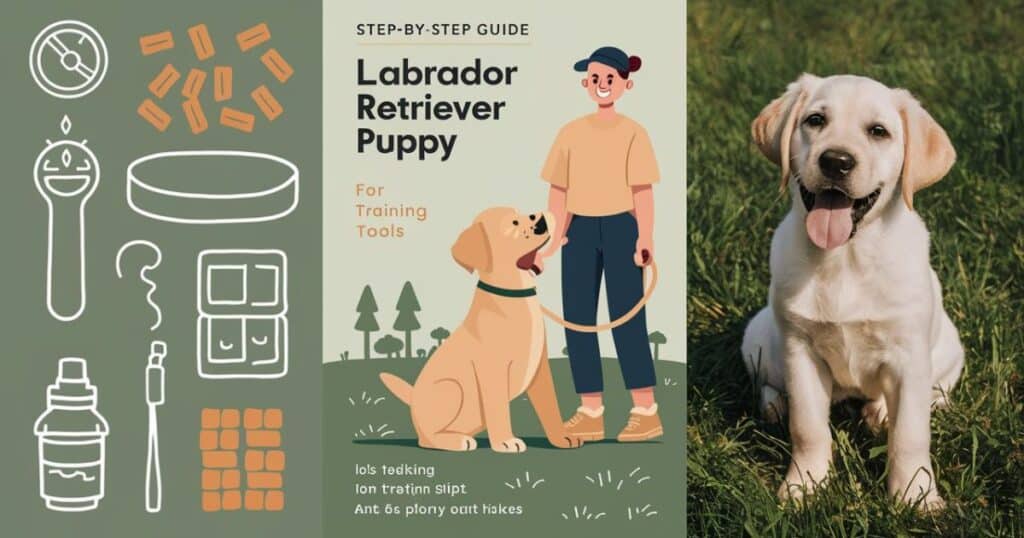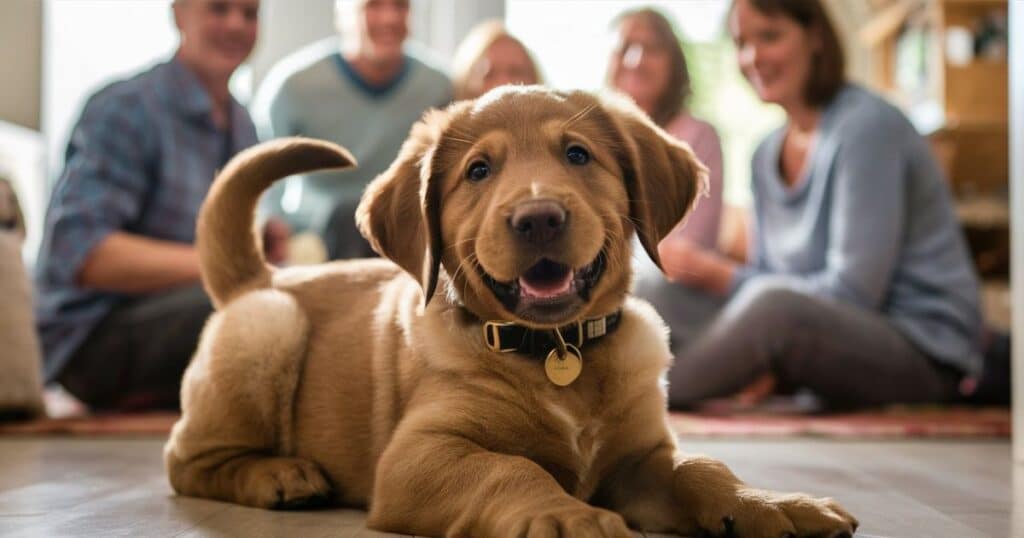Labrador Retrievers have become one of the most popular dog breeds in the United States, the United Kingdom, Canada, and beyond. With their friendly personalities, versatile abilities, and adorable puppy antics, it’s no wonder Labs makes such great family companions. This guide will explore what makes American Labrador Retriever puppies so beloved and provide insights into their care, training, and health needs.
The Labrador breed originated in the Canadian province of Newfoundland, where they were bred to assist fishermen by retrieving nets, and ropes, and even hunting waterfowl from icy waters. As the breed gained popularity in 19th century England, the ancestors of today’s American Labs were brought across the Atlantic. While their amazing retrieving abilities remain, Labrador Retrievers have transitioned into primarily cherished family pets and versatile working dogs.
The Basic American Labrador Puppy Traits

One of the biggest draws of the Labrador Retriever is their outgoing, friendly temperament. From an early age, Lab puppies greet everyone they meet with enthusiastic tail wags and licks. Their amiable, loving nature makes them patient, gentle companions around children.
“They pretty much love everybody they meet – kids, adults, and other pets. You could call it the stereotype of the friendly dog, but it’s 100% true with Labs.” – Professional dog trainer, Mark Hogan
At the same time, these bundles of energy require plenty of exercise and activity. American Labrador pups have high energy levels and stamina, stemming from being bred as athletic water-retrieving dogs. Without sufficient outlets like walks, runs, swimming, or playtime, that energy can turn into unwanted behaviors like chewing, digging, or general mischief around the house.
Their eager-to-please attitude and high intelligence also make Labs incredibly easy to train from a young age. With positive reinforcement methods like treats and praise, Labrador Retrievers quickly learn basic obedience commands as well as more advanced tricks and skills. They truly live to make their owners happy.
One comical example of the Lab’s loving, goofy nature:
During a local pet store’s puppy training class, an 8-week-old yellow Lab named Charlie kept joyfully interrupting lessons by climbing onto his owner’s lap and showering her face with wet kisses. After some gentle repositioning, Charlie soon learned to contain his enthusiasm – but only until the training session ended, at which point he buried his owner in a fresh barrage of affectionate licks and wiggles.
ALSO READ: THE TAN LABRADOR RETRIEVER: A COMPREHENSIVE GUIDE
Caring for Your Labrador Retriever Puppy
While their fun-loving personalities make Labs wonderful companions, they do require certain care and living accommodations as puppies.
These energetic pups need:
- Plenty of exercise: At least 1-2 hours per day, split into multiple walks, play sessions, etc. Fenced yards are ideal for safe romping. In apartments or smaller living spaces, dog parks and runs provide an outlet for burning energy.
- A nutritious diet: High-quality puppy food formulated for larger breeds, with a balance of proteins, fats, carbs, vitamins, and minerals to fuel their growth and energy levels. Avoid free-feeding and stick to a consistent meal schedule.
- Regular grooming: Labs have a short, dense double coat that sheds moderately. Weekly brushing, plus bathing every 4-6 weeks, helps control shedding and keeps their coat looking its best.
- Early socialization: Exposing Lab puppies to different people, places, sounds, and experiences from 8-12 weeks builds confidence and prevents fear issues.
New Labrador Retriever Puppy Checklist
- Premium large-breed puppy food
- Food/water bowls
- Full puppy grooming kit (brush, shampoo, etc.)
- Durable chew toys
- Comfy dog bed
- Adjustable collar and leash
- Puppy pads/crate for house-training
- ID tags with your contact info
Providing this foundation of care will help lay the groundwork for a well-behaved, healthy, and happy Lab as they grow into adulthood.
Labrador Retriever Puppy Training Made Simple

Training is crucial for Labrador Retrievers, both to prevent common behavior issues and to provide the leadership, structure, and mental stimulation they crave. The earlier you start training, the better – but the process should always focus on positive reinforcement rather than punishments.
“With their food-motivated disposition and eager-to-please attitude, American Labs respond incredibly well to reward-based training using treats, praise, and play.” -Karen Pryor, Author of ‘Don’t Shoot the Dog’
Here are some tips for basic obedience training with your Lab puppy:
Sit
1. Hold a treat near your puppy’s nose
2) Slowly move it back over their head – they’ll naturally sit as they follow the treat
3) As their bottom hits the floor, give the ‘sit’ command and reward
4) Practice for 5-10 minutes per day, phasing out the need for a treat over time
Stay
1) Start with your puppy in a sitting position
2) Hold up an open palm as a ‘stay’ signal and take one step back
3) If they stay seated, give praise/treat and release them with ‘okay’
4) Gradually increase time/distance as they improve
Come
1) Squat down holding a treat near your chest
2) Call your puppy’s name and give the ‘come’ command
3) When they reach you, reward with the treat/praise
4) Practice in an enclosed area first, then move to distracting environments
Pro Tip: For house-training, set up a consistent schedule and use positive reinforcement like treats whenever your Lab puppy eliminates outside. Crate training and limiting the space in your home can also help prevent indoor accidents.
American Lab Pup Health & Preventive Care
Part of being a responsible Labrador Retriever owner is being proactive about your pet’s preventive healthcare.
Some key aspects to focus on:
- Vaccinations: Puppy vaccinations like distemper, parvo, and rabies are crucial. Follow the schedule your vet recommends, usually starting around 6-8 weeks.
- Deworming: Labs are susceptible to intestinal worms and will need deworming medications, typically starting at 2-4 weeks old.
- Flea/Tick/Heartworm Prevention: These medications help protect your body against parasites that can cause dangerous conditions. Start as soon as your vet advises.
- Spaying/Neutering: Most vets recommend spaying females and neutering males at around 6 months of age to avoid unwanted litters and certain health issues.
- Hip/Elbow Evaluations: As a larger breed, Labs are prone to hip and elbow dysplasia. Screening radiographs can identify any issues early.
Finding a responsible breeder is also key, as they should screen parent dogs for genetic conditions and provide detailed medical records for each puppy. Avoid pet stores, puppy mills, and online sellers with limited information.
Labrador Retriever Puppy Veterinary Care Checklist
- Core puppy vaccines (Distemper, Parvo, etc.)
- Deworming regimen
- Monthly heartworm/flea/tick preventatives
- Spay/neuter surgery
- Hip/elbow screening
- Annual wellness exams and recommended lab tests
By prioritizing preventive healthcare from a young age, you’ll help ensure your Lab lives a long, healthy, happy life as part of your family.
Conclusion
There’s no doubt that the American Labrador Retriever makes an absolutely delightful family companion. With their friendly, upbeat personalities and boundless capacity for love and affection, Lab puppies bring constant joy to their owners’ lives.
However, these energetic, high-maintenance pups do require a serious commitment to providing the right care. From extensive daily exercise and activity to training, grooming, and preventive veterinary care, being a Lab owner takes time, effort, and dedication.
If you take the time to understand the breed’s needs and have the means to fulfill them, you’ll be rewarded with a loyal, loving friend for life. American Labrador Retrievers live to please their human companions. With proper upbringing, they mature into well-behaved, eager, loving adult dogs who make fabulous lifelong household members.
So if you’ve been considering adding an adorable Lab puppy to your family, I hope this guide has provided valuable insights to make that decision. Just be sure you’re truly prepared to take on a boisterous puppy who will ultimately grow into an energetic, 60.
ALSO READ THIS POST: THE BELOVED ENGLISH CREAM LABRADOR RETRIEVER: AN IN-DEPTH GUIDE
FAQ’s
What is the difference between an American Labrador and a Labrador?
There is no difference between an American Labrador and a Labrador Retriever. “American Labrador” is not an officially recognized distinct breed. The Labrador Retriever breed originated in Newfoundland, Canada, but was further developed and popularized in both the United States and the United Kingdom. So American Labradors are simply Labrador Retrievers bred and born in the United States, but they are one and the same breed.
How big do American Labrador retrievers get?
American Labrador Retrievers are a large breed. On average, adult male Labs weigh between 65-80 pounds and stand 22-24 inches tall at the shoulder. Females tend to be slightly smaller, weighing 55-70 pounds and standing 21-23 inches tall. However, there can be variations, with some Labs falling above or below these standard size ranges.
Is an American Lab a good family dog?
Yes, American Labrador Retrievers make excellent family dogs due to their friendly, energetic, and eager-to-please temperament. They are affectionate with children, get along well with other pets, and have the stamina to keep up with an active family lifestyle. Their intelligence and trainability also make them well-suited for households willing to provide proper exercise, socialization, and obedience training from an early age.
What is the calmest breed of the lab?
While all Labrador Retrievers tend to be friendly, social, and relatively energetic dogs, the English Labrador is generally considered to be the calmest, most laidback breed line within the breed. English Labs were bred with more of an emphasis on being instinctive retrievers and calmer family companions, as opposed to American or Field-type Labs bred for increased drive and stamina in hunting trials. However, much of a lab’s energy level and temperament depend on proper exercise, training, and socialization, regardless of their specific lineage.

Davin Connor is an experienced author with 3 years in pets writing. Known for concise, informative content, he shares expertise on pet care, behavior, and health through his engaging articles.






